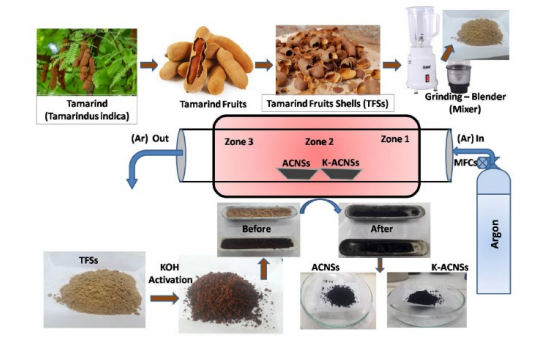Tamarind is a tropical fruit consumed by people across the globe. Its shells are thrown away during food production. Tamarind shells are heavy and occupy a significant amount of space in landfills where they are disposed of as agricultural waste.
 A representation of the experimental process, as well as photographs of the tamarind shell at every step. Image Credit: Nanyang Technological University.
A representation of the experimental process, as well as photographs of the tamarind shell at every step. Image Credit: Nanyang Technological University.
A group of international researchers headed by Nanyang Technological University, Singapore (NTU Singapore), has now come up with a method to address this issue. The researchers treated the tamarind shells that are rich in carbon and transformed them into carbon nanosheets, which are a main component of supercapacitors — energy storage devices utilized in electric vehicles, buses, automobiles, elevators and trains.
The study shows NTU’s dedication to tackling major challenges facing humanity on sustainability as part of its 2025 strategic plan, the aim of which is to expedite the translation of research discoveries into innovations that alleviate the effect on the environment.
The research group involved scientists from NTU Singapore, the Western Norway University of Applied Sciences in Norway, and Alagappa University in India. They consider that scaling up such nanosheets could be an eco-friendly substitute to their industrially produced counterparts while reducing waste.
Through a series of analysis, we found that the performance of our tamarind shell-derived nanosheets was comparable to their industrially made counterparts in terms of porous structure and electrochemical properties. The process to make the nanosheets is also the standard method to produce active carbon nanosheets.
(Steve) Cuong Dang, Study Lead Author and Assistant Professor, School of Electrical and Electronic Engineering, Nanyang Technological University
According to Professor G. Ravi, Head of the Department of Physics, and co-author of the study with Assistant Professor Dr. R. Yuvakkumar, both from Alagappa University, “The use of tamarind shells may reduce the amount of space required for landfills, especially in regions in Asia such as India, one of the world’s largest producers of tamarind, which is also grappling with waste disposal issues.”
The study was reported in the peer-reviewed scientific journal Chemosphere in June 2021.
The Step-by-Step Recipe for Carbon Nanosheets
The carbon nanosheets were manufactured by initially washing tamarind fruit shells and drying them at a temperature of 100 °C for about 6 hours before they were ground into powder.
Then, the researchers baked the powder in a furnace for about 150 minutes at a temperature of 700 °C to 900 °C without oxygen. Thus, they transformed them into ultrathin sheets of carbon called nanosheets. Tamarind shells are porous in nature and rich in carbon, which makes them a perfect material from which carbon nanosheets can be synthesized.
Industrial hemp fibers are common materials utilized to generate carbon nanosheets. Yet, they must be heated to more than 180 °C for 24 hours — four times longer compared to that of tamarind shells, and at a higher temperature. This process falls before the hemp is additionally subjected to intense heat to transform them into carbon nanosheets.
Carbon nanosheets comprise of layers of carbon atoms arranged in interconnecting hexagons, like a honeycomb. The secret behind their energy storing capabilities lies in their porous structure leading to large surface area which help the material to store large amounts of electric charges.
Dhayalan Velauthapillai, Professor and Head of the Research Group for Advanced Nanomaterials for Clean Energy and Health Applications, Western Norway University of Applied Sciences
Velauthapillai contributed to this study. Moreover, the tamarind shell-derived nanosheets exhibited good electric conductivity and thermal stability, thus making them potential options for energy storage. The team looks forward to investigating the larger-scale production of the carbon nanosheets along with agricultural collaborators.
Moreover, the team is working to decrease the energy required for the production process, thereby making it more eco-friendly. They are also looking to enhance the electrochemical properties of the nanosheets. The researchers intend to explore the chances of employing various kinds of fruit skins or shells to generate carbon nanosheets.
Journal Reference:
Thirumal, V., et al. (2021) Cleaner production of tamarind fruit shell into bio-mass derived porous 3D-activated carbon nanosheets by CVD technique for supercapacitor applications. Chemosphere. doi.org/10.1016/j.chemosphere.2021.131033.